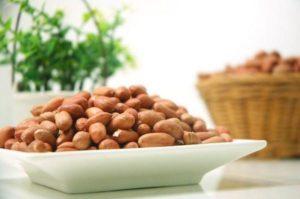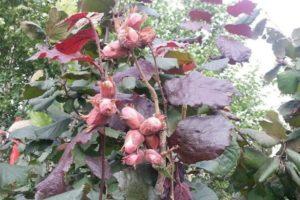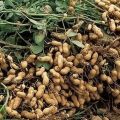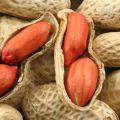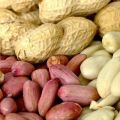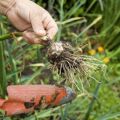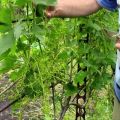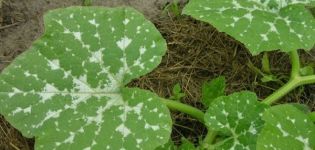How can you grow peanuts in the country in the middle lane, the rules of planting and caring for the crop
Peanuts are a rare crop in most regions of the country. Despite its low prevalence, crop cultivation does not require special training and complex agricultural techniques. Having figured out how to properly grow peanuts in the country in the middle lane, you will be able to get a large harvest without problems.
Is it possible to grow peanuts in central Russia?
Climatic features and soil type in the middle zone of the country are suitable for planting peanuts. To safely breed a crop, it is enough to follow the standard growing rules, choose a suitable place to place the plantings and provide full care.
The best varieties for the region
When choosing a variety of culture, you need to decide on the purpose of growing. If you plan to land for further production of peanut butter, you should pay attention to varieties such as Valencia, Runner, Olin, Virginia, Tamrun Oil. For growing crops for the sake of the nuts themselves, it is recommended to plant varieties of Adyg, Stepnyak, Bayan, Acorn, Zagatala.
If you plant one of the listed varieties and propagate it from the grown crop in the future, the culture will eventually adapt well to climatic characteristics and will bear fruit better.
The subtleties of growing a culture
There are a few things to consider to reduce the risk of problems while growing peanuts. The culture will develop better provided that the seed is properly prepared, a suitable area is selected, the soil is cultivated and the subtleties of sowing for seedlings are observed.

Preparation of planting material
Before sowing, peanuts must be carefully examined and specimens must be selected without damage, rot and other defects. The selected seed is disinfected within 15-20 minutes by placing it in a weakly concentrated solution of potassium permanganate. Then the nuts are soaked in warm water throughout the day for germination.
How to choose the right place for landing
Peanuts should be planted in a constantly lit area, where no shade falls during a sunny day. At the location of the beds, groundwater should not be high. You should also select an area that does not have blow-through.
Nuances when choosing
In addition to the standard conditions, when choosing a site for a peanut crop, it is important to pay attention to a number of nuances.To obtain a large harvest, the type of soil, the previous crop and the correct implementation of sowing work are important.
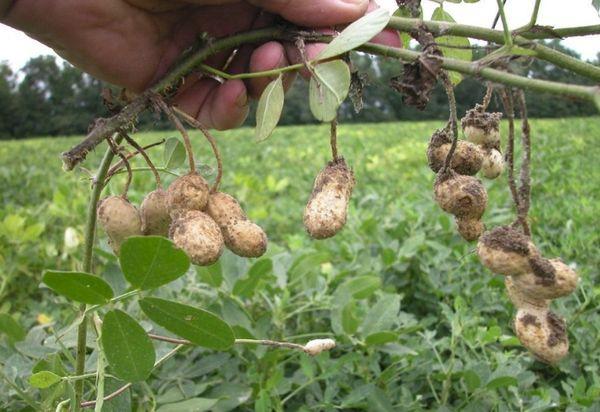
Priming
Growing peanuts in the Moscow region in the open field, as in other regions of the middle lane, is recommended to be carried out on light, loamy and sandy loam soil. The acidity indicator of the soil should be neutral, since the culture does not take root in acidified and saline areas. If the soil is too acidic, before planting, it will be necessary to process it with dolomite flour or dry lime.
Predecessors
Beets, tomatoes, corn, pumpkin and onion crops are best suited as precursors for peanuts. After growing these plants in the ground, there is a saturation of nutrients that have a positive effect on the growth and development of peanuts. It is also important to follow the rules of crop rotation and not plant legumes in one place for several years in a row.
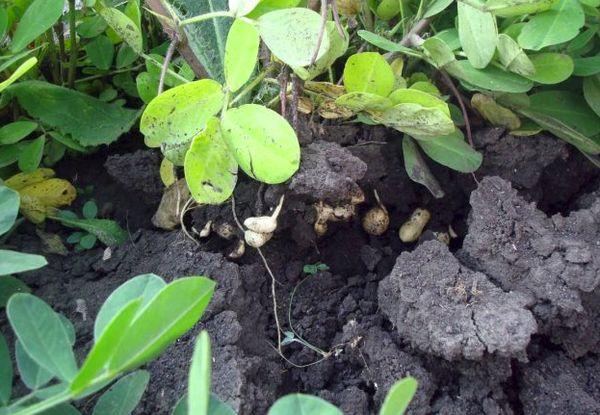
Sowing
Sowing seedlings of peanuts requires a spacious container - at least 30 cm in diameter. Sowing is performed in the following order:
- moistened earth is poured into the prepared container;
- germinated seed is planted in the center to a depth of 2-2.5 cm;
- to maintain a comfortable microclimate, the container is covered with plastic wrap or a lid.
The specifics of the seedling method
Before the first shoots appear, peanut seedlings are periodically ventilated and moistened as the earth dries up. After the formation of the first pair of leaves, the film is removed from the container. Then the seedlings are left in a bright place, for example, on an insulated windowsill. After 2 weeks of development from the moment the sprouts were detected, the seedlings are transferred to a permanent place in unprotected soil. If legumes are grown in decomposable peat pots or tablets, they can be dived without removing them from the container.

Peanut care features in the middle lane
Having planted peanuts in a permanent place, you should take care of the plantings during the entire growing season. An important condition for growing in the middle zone is to ensure a balanced temperature regime. Peanuts are heat-loving crops, and cultivation should take place at a temperature between 20-27 degrees.
Temperatures below 15 and above 30 degrees lead to plant death.
Watering, loosening and weeding
It is necessary to moisten the beds with plants regularly, checking the condition of the soil before each irrigation. Drought and waterlogging should not be allowed, so as not to disrupt the development of peanut roots. At the moment of active formation of inflorescences, an increased introduction of moisture is required. In hot weather, it is recommended, in addition to watering, to spray the ground part of the plants twice a day - in the early morning and after sunset.
Each watering is accompanied by soil loosening. An agrotechnical technique is necessary so that the water better passes to the roots located below and stays longer in the ground. Simultaneously with loosening, weeding of peanuts is carried out, removing weeds and plant residues.

When cultivating the land, it is additionally required to carry out hilling. The need arises 1.5-2 months after planting the plants, when they begin to lean towards the ground, and the ovaries will sink into the ground. It is important to track this moment and spud the plantings with loosened and moistened soil. Throughout the entire growing season of peanuts, hilling is carried out twice - 10 and 20 days after flowering. As an alternative to hilling, you can leave a layer of mulch from sawdust, humus and sand on the garden bed.
Top dressing
The first fertilizer is applied to the ground 2-3 weeks after the transfer of peanuts to a permanent place of growth.A complex mixture of potassium salt, superphosphate, water and ammonium nitrate is used as a top dressing. The use of top dressing allows you to activate the growth of seedlings, helps to build up green mass and has a positive effect on the taste characteristics of the crop.
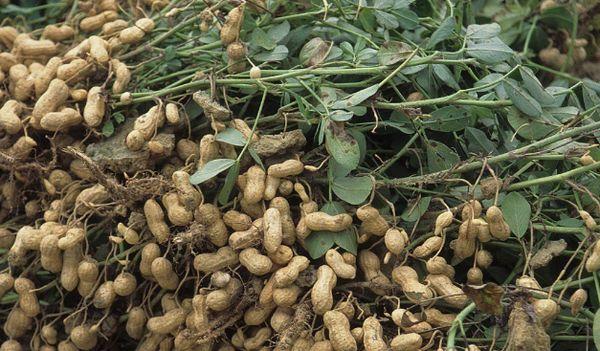
The second dressing is applied at the beginning of fruiting. If the peanuts are planted in fertile soil, a second dose of fertilizer is optional. In case of delayed development and unfavorable environmental conditions, it is allowed to additionally use growth stimulants.
Protection from ailments and insects
For peanuts, diseases such as powdery mildew, fusarium, gray rot and phyllostictosis are dangerous. Having found the symptoms of diseases, it is necessary to treat the plants with fungicidal preparations. Overly affected parts of the plantings are cut and removed. In advanced cases, it may be necessary to completely remove the hives to stop the spread of the infection.
Among harmful insects, caterpillars, thrips and aphids affect the culture. Protective insecticide sprays are helpful against pests. Large parasites can be harvested manually from the beds.
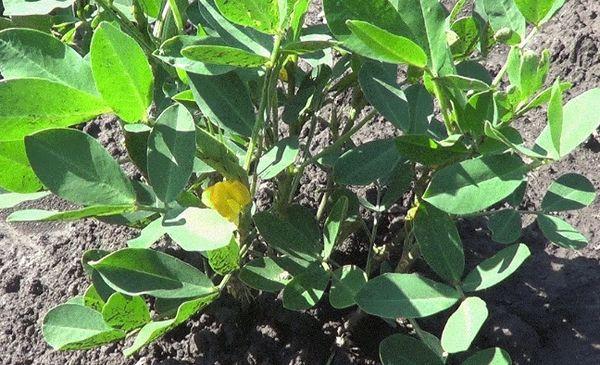
Harvesting peanuts
The harvest season is in September. In anticipation of digging up the nuts, it is necessary to stop watering and wait until the top layer of the earth dries up, which will make the collection process more convenient. As a rule, up to 50 pods containing 6-7 nuts are formed on each bush.
The exact amount of the crop depends on the characteristics of the cultivated variety, climatic conditions, soil fertility, and the quality of agricultural technology.
Having dug up the plants, it is necessary to turn the bushes upside down and shake off the remnants of the earth. The peanut pods are then stored in a shaded dry place. It is desirable that the space is well ventilated. The nuts are dried until the peanuts acquire a slightly darker shell with pronounced splashes. After that, a few peanut pods can be left for further propagation, and the rest of the crop is ready to eat.
